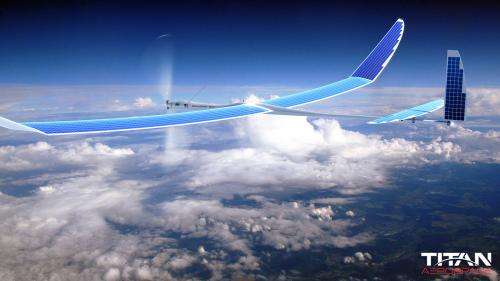August 22, 2013 weblog
Titan Aerospace readies solar-powered, long-endurance UAVs

(Phys.org) —A New Mexico company, Titan Aerospace, founded in 2012, is taking a serious step in launching unmanned aircraft that can function as satellites but at far less cost. Making news earlier this month at the Association of Unmanned Systems International (AUVSI) conference and exhibition in Washington, the company introduced its Solara 50 and Solara 60, behaving as long-endurance solar powered drones and described by the company as atmospheric satellites.
The Solara 50 is under construction and will be ready for next year, with the bigger Solara 60 to follow. They are powered by solar energy and capable of staying in high altitudes for weeks, even years. Coming up with a high-altitude, extreme-endurance solar UAV has required skills and expertise and this company thinks it has a solid answer in the Solara. According to Green Light, the company already tested in the New Mexico skies a smaller, proof-of-concept vehicle with a 33-foot wingspan, while longer endurance tests are planned. The Solara 50 is scheduled for next year.
Titan Aerospace aircraft are to be launched by catapult and can land by skidding on the underside. The Solara can cruise at 65,000 feet at a maximum speed of around 60mph, carrying a 70-pound payload. The UAV is capable of carrying telecom, reconnaissance, atmospheric sensors and other payloads.
Unencumbered by weather, the Solara shines day and night, according to the company. Solara has been designed with thousands of high efficiency solar cells placed on virtually every possible surface. According to the company, 3,000 solar cells cover the upper wing surface, the elevator and the horizontal stabilizer. Extra energy generated during the day is stored in lithium ion batteries located inside the wing. The batteries power flight at night. The battery management system ensures voltage and thermal thresholds are maintained in subzero atmosphere. The aircraft is designed to fly up to 65,000ft altitude and remain there for long durations; some reports say for five years. The Solara 50 has a 164-feet wingspan.
While the Solara 50 will have a payload of just 70 pounds, the next design in line, the Solara 60, will carry up to 250 pounds. The company notes the vehicles are capable of carrying telecom, reconnaissance, atmospheric sensors and other payloads.
To promote this long-flying drone, the company's sales message is simple. When persistent coverage is needed, satellites have in the past fit the bill but the upcoming Solara vehicles will be able to perform similar tasks normally reserved for satellites at lower cost.
Unlike space satellites, according to the company, Solara is easier to maintain, as it can be brought back for maintenance or payload upgrades. Titan Aerospace sees many potential uses for the Solara. Asset tracking, search and rescue, pipeline monitoring, disaster recovery, atmospheric and weather monitoring, and fire monitoring are just some examples.
More information:
titanaerospace.com/
greenlightnational.com/solar-p … onths-or-even-years/
titanaerospace.com/wp-content/ … 0_BROCHURE_EMAIL.pdf
arstechnica.com/information-te … mospheric-satellite/
© 2013 Phys.org




















